12 Best Indoor Plants To Thrive in Apartments (And Their Pros & Cons)
Houseplants are one of the simplest and easiest ways to add vibrant touch and life into your house. After all, there’s nothing better than bringing nature inside. Not to mention, the best indoor plants also purify air within your home.
Beautiful and rubber plants and umbrella trees are great for adding a finishing touch to any room while filling up the empty walls and corners with greenery. These plants are perfect for all types of apartments – be they large homes or tiny/less spacious apartments. Not just these two, there are ample choices for small plants to keep indoors while providing a balanced touch of greenery into your home. Moreover, it won’t take up a huge chunk of living space.
Also Read: Best Living Room Plants to Dress Up Your Space
With small plants, like aloe vera or succulents, you can easily add a green touch to your desk, end table, nightstand, or any other area in a room. Slightly bigger plants, such as peace lilies, are also great for taking up some floor space in your house. However, they won’t overwhelm the corner of a room with big roots or lush leaves.
The best part about some potted plants is that they are easy to fit in any indoor space. You can be a little creative and think of adding some cute plants in usual or unexpected areas in your home, such as the bathroom window. Or, consider hanging a planter with a space-saving vertical garden. So, this way the best indoor plants will make your home more lively and aesthetically appealing.
Best Indoor Plants For Your Apartment – And Their Pros & Cons
1. Aloe Vera – One of The Best Indoor Plants

Aloe Vera plants make amazing houseplants. These are the best indoor plants that prefer indirect, bright light. While this plant thrives well in moist soil, it seems to grow finely even if you forget to water it regularly. Although it is native to southern Africa, Aloe vera is now one of the common household plants due to its usefulness.
PROS
* Aloe vera can absorb CO2 while releasing oxygen at night, making it a great plant to keep in bedrooms.
* The interior of the aloe leaf has gel-like sap that is useful in healing burns and cuts.
* It can regularly form plantlets, which are easy to remove and plant in a new container.
CONS
* If you keep aloe vera in the summer sun, it can surely attract a lot of pests. The juices formed in this succulent attracts sap-sucking insects. If you notice this, it is important to eliminate those insects using an insect-killing plant soap.
2. Spider Plant – Air Purifying Best Indoor Plants

Spider Plants are amazing for indoors a great indoor plant that purifies the air. These are the best indoor plants to thrive even if not maintained occasionally. So, even if you don’t water them regularly, they will remain in good condition in moist soil.
You can keep spider plants in moderate to bright light. However, avoid keeping them in direct sun. You can fertilize them twice a month during summer and spring.
PROS
* Spider plants are safe for pets.
* They can remove carbon monoxide, benzene, xylene, and formaldehyde from the air.
CONS
* Spider plants are slightly hallucinogens for cats.
3. Ficus
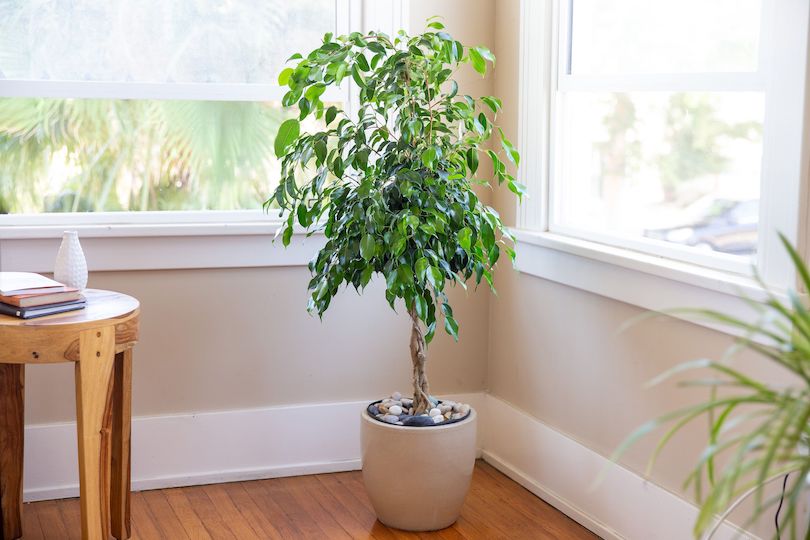
Ficus is a great indoor plant to purify the air in your home.
These are the best indoor plants for homes and offices. Why are these plants considered great for indoors? It is because they not just have a striking appearance but are also very effective at purifying indoor air.
These plants prefer indirect, bright light and occasional misting for keeping the soil moist. Make sure you keep them away from drafts.
PROS
* All thanks to its decorative appearance, ficus serves as a focal point in any room.
* It is great to purify indoor air.
CONS
* If pets chew it, they may experience diarrhea or vomiting.
* Ficus sap causes skin irritation to people and pets.
* Keep ficus in one area of a house, this plant doesn’t like relocation.
4. Peace Lily – Best Indoor Plants

Peace Lily is one of the best indoor plants for growing in water.
This plant provides beauty and elegance to the given space with a unique look. It often prefers indirect, bright light. However, it also does well in indirect, medium light. When requires water, it gets droopy leaves. After proper watering, it gets back to its best condition. You can even consider occasional misting for extra humidity.
PROS
* This plant helps in removing formaldehyde, benzene, toluene, trichloroethylene, and xylene from the surrounding air.
CONS
* It includes oxalates that may lead to contact dermatitis or skin irritation. The skin irritation may occur due to the salt crystals. these components can lead to a fiery burning sensation if chewed, eaten, or crushed. Even curious pets may experience skin irritation on chewing or eating this plant.
5. Red Edged Dracaena Plant
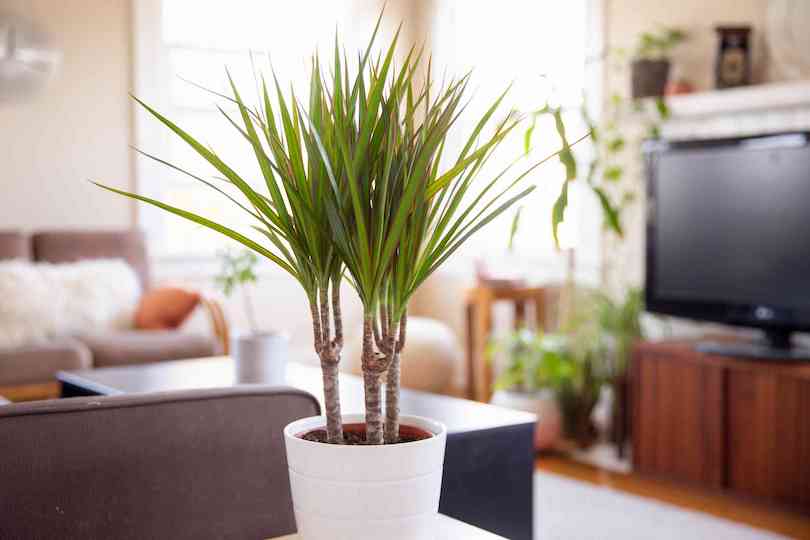
Red-edged dracaena, or dragon tree, is a useful and beautiful plant for purifying indoor air. It needs a brightly lighted area for growth. However, it can even grow well in lower light conditions. Let it dry out between watering sessions to let it thrive naturally.
PROS
* Dracaena is great for removing xylene, formaldehyde, and trichloroethylene from your home. All these airborne chemicals may emanate out of a variety of household goods.
CONS
* This plant is susceptible to leaf spotting if leaves become moist or wet while watering. Keeping this in mind, make sure to water only the plant base – not the upper portion of the plant or its leaves.
* It may attract pests called thrips. But insect-killing soap or other plant-insect killers can cure this condition.
6. Boston Fern
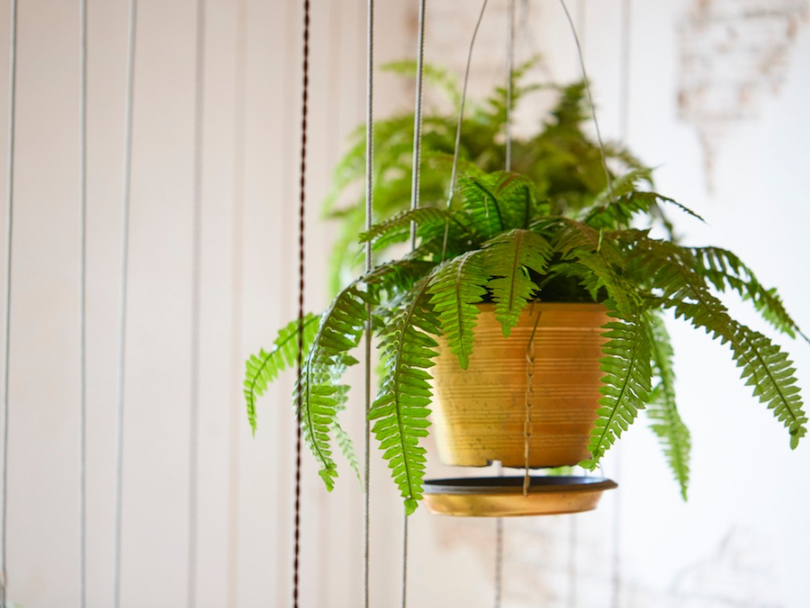
These are among the best indoor plants for air purification.
Boston ferns may grow large and become showy. However, these are a beautiful addition to your abode. They do well in bathrooms and other rooms that are often humid with natural, soft light. Give them slight moisture while enabling them to dry out during the winter months. They also don’t need a new pot unless you decide to grow them bigger.
PROS
* Ferns are nontoxic.
* As per a study published in 2011, ferns have greater ‘formaldehyde-removal efficiency” than other indoor plants.
* They are also known to remove xylene and toluene from indoor air.
CONS
* Boston ferns are most susceptible to rotting from roots. So, water them only until water leaks from its drain holes.
* Also, keep a vacuum handy – as these plants are messy when leaves drop.
7. Snake Plant

Snake Plants is great for cleaning indoor air.
Also called mother-in-law’s tongue and Sansevieria trifasciata, the snake plant adds a unique appearance into your living space. Its hardy and unique look can amp up to home decor with its strap-like, upright leaves. It can even tolerate low light and water environments, although it wants indirect, bright light.
PROS
* Snake plants are even on NASA’s list of best indoor plants to filter and clean indoor air.
* It is very easy to care for snake plants. You just have to water them at their base. They may survive even with fluorescent lighting. If kept in a window, just rotate these plants weekly for a quarter turn.
CONS
* Saponins present in the snake plant leaves are toxic to pets, as they can cause vomiting and nausea.
8. Golden Pothos

It is a great indoor plant for offices.
Even if you believe you have a ‘ black thumb,’ you can still grow golden pothos. It grows well even in low light and also if you miss watering occasionally. This plant also require some drying out in-between watering sessions.
PROS
* While root rotting is a common issue with many houseplants, this indoor plant rarely succumbs to such a condition.
* The golden pothos is a very common houseplant that’s easy to grow and very attractive.
* It is great for the air-purification of your indoor areas.
* If the leaves begin to be droopy, you’ll know that it needs watering. Droopy leaves that cannot revive after watering means you need to report it into a larger container.
CONS
* This indoor plant is toxic for ingesting due to the presence of oxalates. So, keep it far from children and pets who may eat the leaves.
9. Bamboo Palm
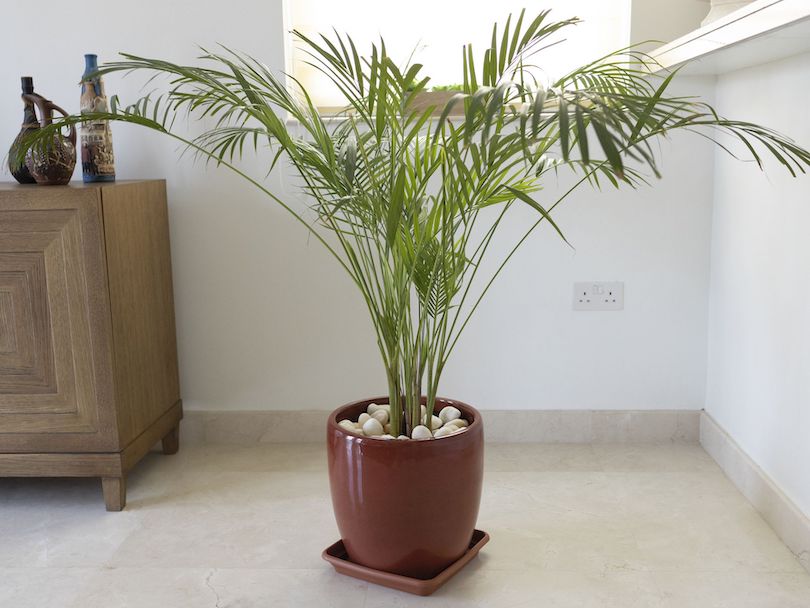
The Bamboo Palm makes a Great Office Plants
Bamboo palms are best to add a tropical vibe to your office/home. Although this plant, also known as parlor palm, needs bright light, it may do well in low light conditions as well. However, you need to provide it enough water to survive. But never overwater! Just wait till its soil gets dry. This plant thrives well in high humidity. So, consider keeping it on a tray of stones and peddles with water. When the water evaporates, put more water until pebbles get covered in water.
PROS
* This plant is not toxic to your pets.
* It is great at decreasing airborne formaldehyde, which is often released from new furniture.
CONS
* The common pests of this plant are spider mites. If you notice any webbing on its leaves, use insect-killing soap on the leaves.
10. Rubber Plant
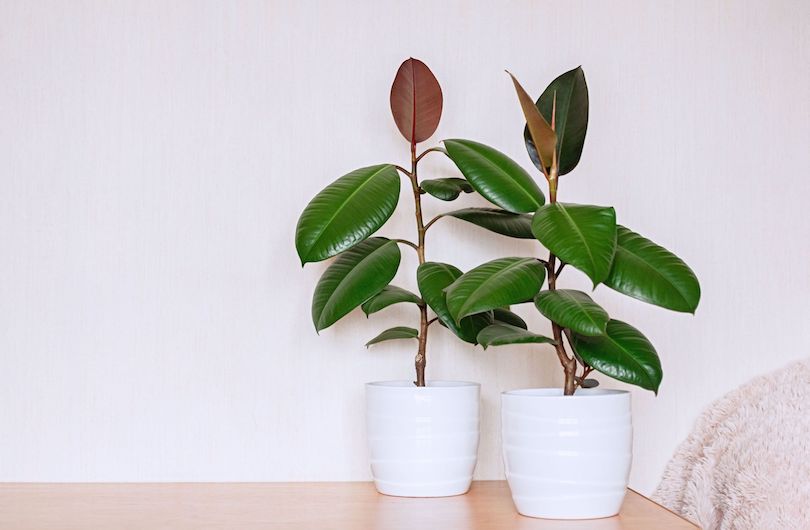
Do you know the rubber plants and ficus from one family? Both belong to the fig family. Rubber plant requires low light to indirect, bright light for thriving. Meanwhile, keep the plant moist. Regular misting is enough to keep the humidity level of this plant. But always nourish it with be room-temperature water. And, avoid over-watering otherwise the leaves will turn yellow.
PROS
* Rubber plants are almost disease-free.
* You will get attractive foliage in your house with this plant.
* This plant is perfect for cleaning indoor air – whether you keep it in your house or office.
* You’ll enjoy attractive, broad foliage offered by the rubber plant.
CONS
* Rubber plants can grow around 10-feet tall in an office or home. So, get ready for a big plant.
* Its milky sap is poisonous to children and pets.
* Its sap may cause some serious skin irritation.
* This plant is very sensitive to temperature alterations. So, keep it somewhere between 55 degrees F to 80 degrees F environment.
11. Chrysanthemum
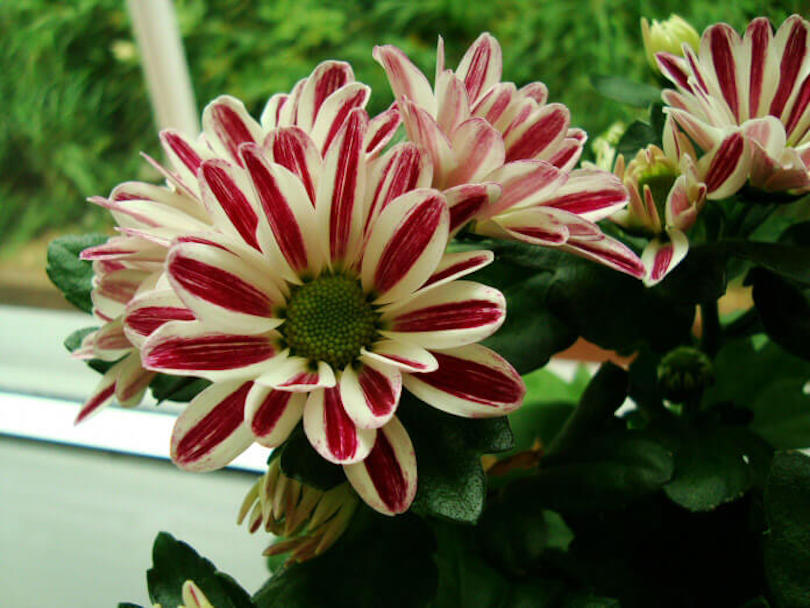
Chrysanthemum, also called mum, is another great indoor plant for purifying indoor air.
This plant is perfect to make your house vibrant and lively with its bright and cheerful flowers. It is very easy to care for and maintain this plant, provided you keep it in a bright location. Moreover, keep the plant in well-drained soil with enough water. When everything is right, you will get attractive blooms to enhance the aesthetics of a room.
PROS
* Mums are also on NASA’s list of top plants for air purification.
* Chrysanthemums cut benzene, ammonia, and formaldehyde from the air inside your house.
CONS
* Mums have a hard time rebloom.
* Leaves of the chrysanthemum plant are toxic to children and pets.
* These flowers are popular for being disposable.
12. Umbrella Tree
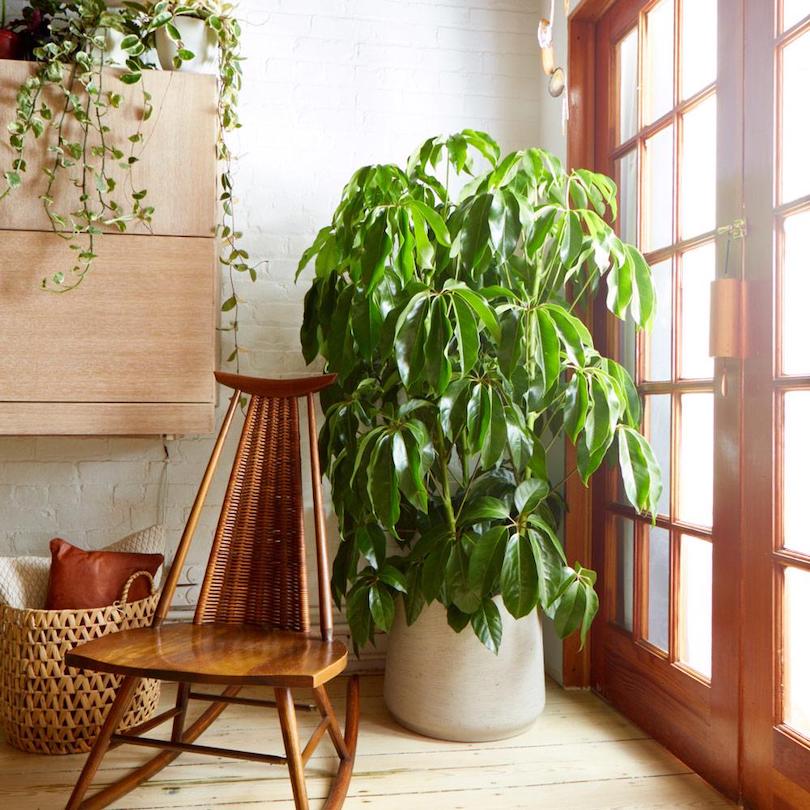
The umbrella tree, also called Schefflera, is a great office or house plant. It is more likely to brighten up a room with greenery if kept in bright, indirect light. It needs moist soil but also thrives even when the soil dries out occasionally.
However, don’t be too generous with watering. It is because this plant cannot grow well in excessive water. Since it can grow up to six feet, you need to pinch off its new growths to sustain normal height.
PROS
* The umbrella tree is popular for purifying the air.
* It needs water only a few times in one month.
* The umbrella tree is a perfect plant to add a showy and bold look for a specific area in your office or home.
CONS
* It is prone to scaling and spider mites. So, keep it in good condition with the right gardening spray.
* Its leaves are toxic to children and pets. Dogs and cats may experience diarrhea and vomiting if they eat it.
